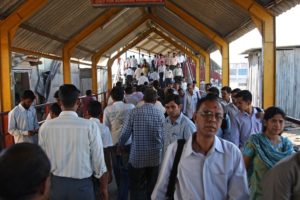IDJ English - Contribution
Maximizing the Effects of High-Speed Railways on the Indian Shinkansen
Nikhil Bugalia, Shreyas Bharule, K.E.Seetharam – ADBI
The first High-Speed Railway (HSR) in India is under construction between Mumbai and Ahmedabad utilizing Japan's Shinkansen technology. What points can maximize the economic effect? The research team headed by Dr. K.E. Seetha Ram, Senior Consulting Specialist at the Asian Development Bank Institute (ADBI), explains.
Railroads support logistics and the economy during the COVID-19 crisis
In the last 5 decades, evolution in rail transport has given birth to highspeed rail (HSR), marking the “second age of rail.” During this time, HSR networks have grown rapidly, reducing the travel time between cities in East Asia and Central Asia while connecting countries in Europe and shrinking the time-space geography of the continents. India is developing its first High-Speed Rail (HSR) project between the cities of Mumbai, in Maharashtra, and Ahmedabad, in Gujarat, one of the prominent economic corridors in India.
On the one hand, there is a strong commitment from the national government in India to develop the first project and commence the work on 6 new HSR lines[1], connecting other prominent economic corridors in India. While, on the other hand, the work on Mumbai-Ahmedabad HSR (MAHSR) line has hit several roadblocks in the recent past, including escalations in cost, an extension of the project schedule, and tepid progress towards land-acquisition[2].
Nevertheless, the work is progressing. In India, questions on whether or not an HSR line is suitable for the country have yet not settled[3]. However, among the chaos, the one positive is the increased interest from several stakeholders demanding to base the decisions on evidence and asking for a detailed understanding of the impacts that the Indian HSR is expected to bring[4].
The Asian Development Bank Institute (ADBI) has also been working collaboratively with the practitioners, academics, and policymakers from around the globe to answer several of the HSR related questions raised in India. Through its 2 year-long activities of reviewing HSR development experiences around the world, gathering evidence for identifying what works and what doesn’t, developing tools and methodologies necessary to support the decisions among policymakers, ADBI has been providing recommendations for evidence-based policies and the means to implement these policies for the ease of decision-makers[5]. In this article, we provide a summary of our findings, while addressing the questions raised previously and providing a pathway to move forward.
The ongoing debate in many Asian countries is not new. Japanese policymakers had a similar debate before HSR was first introduced. Over the years, Japanese HSR has faced public criticism on a number of occasions, but its success is cemented in the firm commitment of all stakeholders to continuously improve the whole system. When starting a new project, it is important to match the HSR system to the socio-economic conditions of a country. Comparing India’s position on certain socioeconomic indicators with that of countries that have introduced HSR gives a reasonable estimate on whether it is suitable to introduce HSR in India.[6]
The suitability of HSR construction is not a question in our view. Through our activities, we have gathered information on a range of socioeconomic indicators for countries with successful HSR systems. Comparing these with the current socio-economic situation in India makes it clear that the economy is mature enough for HSR introduction. In Japan, GDP per capita was $4,700 in 1959, a year when the construction of HSR started. In many European countries, which introduced HSR after that, it was above $14,000 in the starting years of their HSR construction. In China, the figure was $6,200. The collective experience from abroad suggests that GDP per capita of more than $5,000 is suitable for HSR introduction.
India, as one of the fastest-growing economies in the world, reached that mark in 2015. India’s GDP per capita along the proposed Mumbai–Ahmedabad corridor already surpasses that of the Tokyo–Osaka corridor in Japan and many others in mainland China. As of 2017, GDP per capita in PPP terms is more than $6,000, signifying that India meets the criteria of HSR introduction based on the GDP indicator. Further, the overall demand for HSR is also a function of population density in the HSR corridor. The figure below shows India’s comparative position when looking at its current state of GDP per capita and population density along a corridor relative to that of the economy. It is evident that the socioeconomic conditions along the Mumbai–Ahmedabad corridor in India in 2017 make it suitable for HSR construction. The population density for MAHSR is also comparable to the Osaka–Fukuoka corridor, another HSR model case in Japan, operating profitably since the beginning of its inception.
Source[7]
ジャーナル2020年7月号「世界を読む」-300x141.jpg)
While the rationale for the MAHSR project based only on the macroeconomic indicators affecting ridership provides support for the feasibility of the project, the ridership alone is not the only justification for HSR development. Academic studies on the topic under the ADBI umbrella have now also gathered evidence for the significant long-term socioeconomic impacts, known as the spillover effects, at the urban, regional, and national levels. Including such academic evidence in the decision-making process is thus essential to make a sound judgment about the investment. ADBI’s work form the past two years have established beyond doubt, that developing countries have much to gain from the development of transport modes such as HSR that provide high-speed mobility to masses of their population. ADBI’s work provides empirical evidence of the much-debated spillover effects of large-scale transport projects. For example, a positive effect on the average land prices in HSR regions from the start of construction was observed in Taipei, China, with the effect becoming even larger after the beginning of the operation[8]. Similarly, a positive effect on the tax-revenue in the region can also be seen for Kyushu HSR in Japan[9] [10].
The Need to create a long-term development plan including areas along the railway line
While numerous examples of spill-over effects of the HSR projects have been documented in ADBI’s studies, our conclusion is still that HSR development is not a sufficient condition for socio-economic development. Gaining on such benefits often requires long-term integrated planning such that HSR can complement the existing economic activities in the region. In a study examining the relationship between HSR and the agglomeration economy in the scope of specialization and diversity, in Japan, the analysis reveals that both specialization and diversity benefit economic productivity[11].
Yet, a city that is not specialized and does not have a high level of industrial diversity will lose out in the economy. Further, distance to HSR services could affect a city’s specialization and diversity. Hence, the planning of HSR should be conducted in a way so as to enhance the specialization of the regional economy, which requires coordination between several of the national and regional government and business agencies. For example, the data presented for the case of Japan suggests that the mere connection to HSR did not lead to a rise in local economic activities (tourism or the number of businesses, etc.), but only those regions that developed unique strategies using HSR as a tool benefitted.
In Japan, a common practice among local governments is to develop tourist packages in collaboration with HSR operators to promote local tourism. In the absence of these unique characteristics, the chances are that because of the HSR; economic activities might even move away from the region. Hence, efficient coordination between the national and local governments, local businesses, and HSR-operating companies are necessary for realizing the abovementioned benefits.
Further, evidence from academic work emphasizes that intercity and interregional HSR investments can create regional imbalances. When the city or region pairs have different levels of development, such HSR investments may work in favor of larger, so-called primate cities or regions at the expense of weaker surrounding areas. Along a proposed corridor, cities with access to HSR through a station may accrue benefits, although the distribution of impacts and gains requires rigorous study. Cities of regional importance might benefit to the detriment of neighboring hinterlands, although various researchers have argued that countries with dominant cities tend to accumulate net benefits.
Thus, HSR systems should be built to reinforce accessibility and strengthen interregional, as well as intraregional relations[12]. Here, in the light of several ongoing HSR development plans across the world, the Japanese experience in Shinkansen-related regional development provides use cases to learn from for national economic planning, tourism promotion, development around HSR stations, and Transit-Oriented-Development (TOD).
On the other hand, all direct and indirect benefits of the HSR are linked with the level of its usage, which in turn depends on the operational performance of HSR in terms of safety, convenience, and reliability of the services[13]. Here also, a strong partnership between the regulator, the operator, and the passengers is necessary to support continuous improvement in the system so as to achieve the highest level of performance. All successful HSR systems around the world have adopted a wider definition of the railway system comprising not only state-of-the-art technology but also the roles of various human and organizational factors. Further, all parts of the systems are required to evolve in-sync with each other, where the organizational and regulator processes should be able to keep pace with the rapidly changing technical systems so as to create an enabling environment for positive system improvement rather than creating impediments[14].
In conclusion, based on the evidence gathered by ADBI over the course of the past 2 years, the suitability of HSR construction is in India is not a question in our view. However, only when the HSR developing countries have taken sufficient measures to localize HSR as much as possible, through long-term integrated planning, the wider economic benefits of the project, which can last for decades, can be realized. Hence, the success of the upcoming Indian HSR relies on the collaborative efforts of all the stakeholders. Working together, they can ensure that the HSR project delivers on its promises of long-term socioeconomic growth for India. Taking a cue from the announcement on the 6 new HSR corridors in India, the need for the hour is to study the network-effects of HSR in India and abroad so that a consistent long-term plan can be developed and later on implemented for the socio-economic development of India.
International Development Journal 2020 July edition
*****以下、日本語編集記事*****
国際開発ジャーナル7月号 世界を読む
インド新幹線で考える高速鉄道の成果の最大化
アジア開発銀行研究所(ADBI) 上席コンサルティング・スペシャリスト
K.E.シータラム
日本の新幹線の技術を生かし、インドのムンバイ~アーメダバード間で同国初の高速鉄道(HSR)建設が進んでいる。その経済効果を最大に発揮する課題は何だろうか。アジア開発銀行研究所(ADBI)のシニアコンサルティング・スペシャリスト、K.E.シータラム氏が解説する。
コロナ危機の中でも鉄道が物流と経済を下支え
この半世紀の間、鉄道輸送の進化で高速鉄道が誕生し、在来線の時代に次ぐ「鉄道第二期」を迎えている。この間、高速鉄道ネットワークは急成長し、東アジアと中央アジアの都市間の移動時間を短縮させると同時に、欧州諸国を接続し、大陸の時空間の地理を縮小した。
インドでは最初の路線となるムンバイ〜アーメダバード鉄道(MAHSR)の建設が始まっている。だが作業はコストの増加、日程の延期、土地取得の遅れなどに加え、最近は新型コロナウイルスの感染拡大の影響も受けている。それに「高速鉄道はインドに適しているのか」という問いかけも、まだ消えたわけではない。
にもかかわらず、作業は進行中だ。インドではコロナ対策で航空路線や道路交通が封鎖されても、貨物鉄道の多くの路線は運行が継続され、物流と経済を下支えする役割を果たした。コロナ危機の混乱の中でも、鉄道の有用性がエビデンス(論拠)で示されたのだ。
私はインドの高速鉄道をめぐる疑問に答えるため、ADBIでニキル・ブガリア、シュレヤス・バルレ両氏と、世界中の専門家や学者、政策立案者の力を借り、2年間にわたって研究をしてきた。私たちはその中で、高速鉄道が成功した国の社会経済指標について情報を集めた。インドの状況をこれらと比較すると、高速鉄道を導入する上で求められる経済の成熟度にインドは十分に達していることがわかった。
日本では東海道新幹線の建設が始まった1959年の一人当たりGDPは、4,700ドルだった。高速鉄道を導入した多くの欧州諸国では建設開始年で同1万4,000ドル以上、中国では同6,200ドルだった。これらを踏まえると、一人当たりGDPが5,000ドルを超えることが、高速鉄道の導入に適していることを示している。そしてインドは近年、世界で最も急速な経済成長を遂げており、ムンバイ〜アーメダバード間の経済回廊の一人当たりGDPはすでに東京~大阪間や中国本土の多くの地域の建設当時の数値を上回っている。2017年の購買力平価(PPP)換算では一人当たりGDPは6,000ドルを超え、インドがすでにGDP指標に基づく高速鉄道導入の基準を満たしていることを示している。
このほか、沿線の人口密度も高速鉄道の有用性を図る上では重要な指標だ。下の図にある矢印は、世界の高速鉄道沿線の人口密度と一人当たりGDPにおけるインドのポジションを示している。2017年のムンバイ〜アーメダバード沿線の人口密度は、大阪~福岡間にも匹敵する。こうした社会経済的条件により、高速鉄道はインドに適していることは明らかだ。
私たちの研究は、高速鉄道が都市、地域および国家の各レベルで「スピルオーバー効果」など長期的な社会経済的影響を示す証拠も集めた。例えば台湾では、高速鉄道の建設開始から沿線の平均地価が上昇する効果が見られ、その効果は操業開始後にさらに大きくなった。同様に地域の税収のプラス効果は、日本の九州新幹線にも見られる。
沿線開発を含めた長期的計画の作成が必要
とはいえ、高速鉄道だけでは社会や経済の発展において十分な条件とは言えない。多くの場合、高速鉄道が既存の地域経済活動を補完できるように、統合された長期計画が必要だ。日本での分析によると、沿線の地域が競争力のある特定産業の専門性と幅広い多様性の両方を持つことで、経済に利益をもたらす。逆に専門性を欠き、高度な産業の多様性がない都市は経済で失敗する。さらに、駅までの距離も専門性と多様性にとって重要な要素だ。したがって、高速鉄道計画は、地域経済の専門性を高める方法で実施する必要がある。
日本の例を見ると、高速鉄道との接続だけで観光や地域経済の活性化を促すのでなく、高速鉄道を使った独自の戦略を打ち出し、地域全体が恩恵を受けられるようにしている。日本では、地方自治体が高速鉄道事業者と協力して地元の観光を促進することは一般的だ。こうした利点を実現するには、国と自治体、地元企業、高速鉄道事業者の間で効率的な協力や調整が必要となる。
一方で、高速鉄道への投資は都市間や地域間の不均衡を生み出す可能性もある。都市・地域の開発レベルが異なる場合、高速鉄道投資は経済力が弱い周辺地域を犠牲にし、より大きな都市・地域に利する可能性がある。このため高速鉄道の構築では、駅へのアクセスを高め、地域間・地域内の関係を強める必要がある。日本の新幹線関連の地域開発では、政府による国家経済計画に加え、観光振興、駅前開発、公共交通指向型開発(TOD)が講じられており、これらに学ぶ必要がある。
また、高速鉄道の直接的・間接的利点は、その使用レベルに関連している。これはサービスの安全性、利便性、信頼性の点で高速鉄道の運用パフォーマンスに依存している。ここでも、最高水準のパフォーマンスを達成するため、システムの継続的な改善をサポートするには規制当局、事業者、乗客の間での理解と協力が必要だ。
世界で成功している高速鉄道システムは、最先端の技術だけでなく、さまざまな人間的・組織的な幅広い取り組みをしている。さらに、システムのすべての部分は互いに同期して進化させる必要があり、組織と規制当局のプロセスは、急速に変化する技術システムに対応した環境を実現できる必要がある。
高速鉄道建設がインドにふさわしいものであることは疑う余地はない。ただ、開発途上国が高速鉄道を可能な限り現地化し、長期的な統合計画で十分な対策を講じた場合にのみ、プロジェクトの幅広い経済的利益を実現できる。したがって、インドの高速鉄道の成功はすべての利害関係者の協力次第だ。彼らが協力して初めて、このプロジェクトがインドの長期的な社会経済的成長という約束を確実に果たすことができる。インドではMAHSRに次ぐ新たな6路線の建設準備も始まっている。インドの社会経済発展に一貫した長期計画を作成・実施ができるよう、インドと海外の高速鉄道のネットワーク効果を調査することが大きな課題だ。
(略歴) K. E. Seetha Ram インド工科大学(IIT)マドラス校卒業後、アジア工科大学院で工学修士号、東京大学大学院で工学博士号を取得。シンガポール国立大学リー・クアンユー公共政策大学院客員教授などを経て、2017年から現職。東大空間情報科学研究センター客員教授、東日本旅客鉄道(株)(JR東日本)インド高速鉄道特別アドバイザーも兼務
世界の高速鉄道沿線の人口密度と一人当たりGDP
ジャーナル2020年7月号「世界を読む」-300x141.jpg)
『国際開発ジャーナル』2020年7月号掲載記事
[1] https://economictimes.indiatimes.com/industry/transportation/railways/6-more-routes-identified-for-high-speed-corridors-dpr-ready-in-a-year-railways/articleshow/73730658.cms?from=mdr
[2] https://english.kyodonews.net/news/2020/02/297b586def24-indias-railway-project-with-japan-faces-45-bil-budget-shortfall.html
[3] https://www.asiapathways-adbi.org/2019/10/thinking-beyond-the-suitability-of-high-speed-railway-in-india/
[4] https://economictimes.indiatimes.com/industry/transportation/railways/centre-allots-rs-5-6k-cr-to-bullet-train-maharashtra-will-also-have-to-contribute/articleshow/73982598.cms
[5] https://www.adb.org/adbi/search?keywords=High-Speed+Rail
[6] https://www.adb.org/sites/default/files/publication/497781/adbi-high-speed-rail-services-asia.pdf#page=122
[7] https://www.asiapathways-adbi.org/2019/10/thinking-beyond-the-suitability-of-high-speed-railway-in-india/
[8] https://think-asia.org/handle/11540/10221
[9] https://www.adb.org/publications/impact-infrastructure-investment-tax-estimating-spillover-effects-kyushu-high-speed
[10] https://www.adb.org/publications/innovative-measures-infrastructure-investments
[11] https://www.adb.org/publications/industrial-specialization-or-diversity-high-speed-rail-japan
[12] https://www.adb.org/publications/evolution-high-speed-rail-its-development-effects-stylized-facts-review
[13] https://www.adb.org/publications/high-speed-rail-services-asia
[14] https://www.adb.org/publications/privatization-japan-railways-japan-post-why-how-and-now




